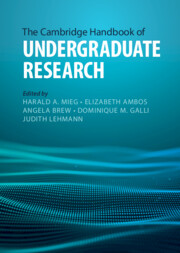Book contents
- The Cambridge Handbook of Undergraduate Research
- The Cambridge Handbook of Undergraduate Research
- Copyright page
- Contents
- Figures
- Tables
- Contributors
- Foreword
- Foreword
- 1 Introduction
- Part I Theory and Research on Undergraduate Research
- Part II Implementation, Approaches, Methods
- Part III Disciplines
- Part IV International Perspective
- 47 Introduction
- Part IV.1 Americas
- Part IV.2 Africa & Middle East
- Part IV.3 Asia & Oceania
- 58 Undergraduate Research in China
- 59 Undergraduate Research in India
- 60 Undergraduate Research in Indonesia
- 61 Undergraduate Research in Japan
- 62 Undergraduate Research in Australia
- 63 Undergraduate Research in New Zealand
- Part IV.4 Europe
- Part V Avenues for Developing Undergraduate Research
- Index
- References
59 - Undergraduate Research in India
Avenues to be Explored
from Part IV.3 - Asia & Oceania
Published online by Cambridge University Press: 11 August 2022
- The Cambridge Handbook of Undergraduate Research
- The Cambridge Handbook of Undergraduate Research
- Copyright page
- Contents
- Figures
- Tables
- Contributors
- Foreword
- Foreword
- 1 Introduction
- Part I Theory and Research on Undergraduate Research
- Part II Implementation, Approaches, Methods
- Part III Disciplines
- Part IV International Perspective
- 47 Introduction
- Part IV.1 Americas
- Part IV.2 Africa & Middle East
- Part IV.3 Asia & Oceania
- 58 Undergraduate Research in China
- 59 Undergraduate Research in India
- 60 Undergraduate Research in Indonesia
- 61 Undergraduate Research in Japan
- 62 Undergraduate Research in Australia
- 63 Undergraduate Research in New Zealand
- Part IV.4 Europe
- Part V Avenues for Developing Undergraduate Research
- Index
- References
Summary
India has a large number of eligible learners ready to enroll in institutions of higher education. There have been numerous attempts on the part of policy makers to cater to the educational needs of such learners and equip them with the essential skills to confidently face the challenges of the competitive job market. These are effectively reflected in the recent government document called National Education Policy 2020, which suggests some fundamental changes to the existing Indian educational sector, including inculcating interest in research among Indian students. At present, some universities provide for undergraduate research as a part of their curricula. Some state governments, e.g., Maharashtra, and the national University Grants Commission have also taken initiatives to improve the quality of undergraduate research in India.
Keywords
- Type
- Chapter
- Information
- The Cambridge Handbook of Undergraduate Research , pp. 543 - 548Publisher: Cambridge University PressPrint publication year: 2022

